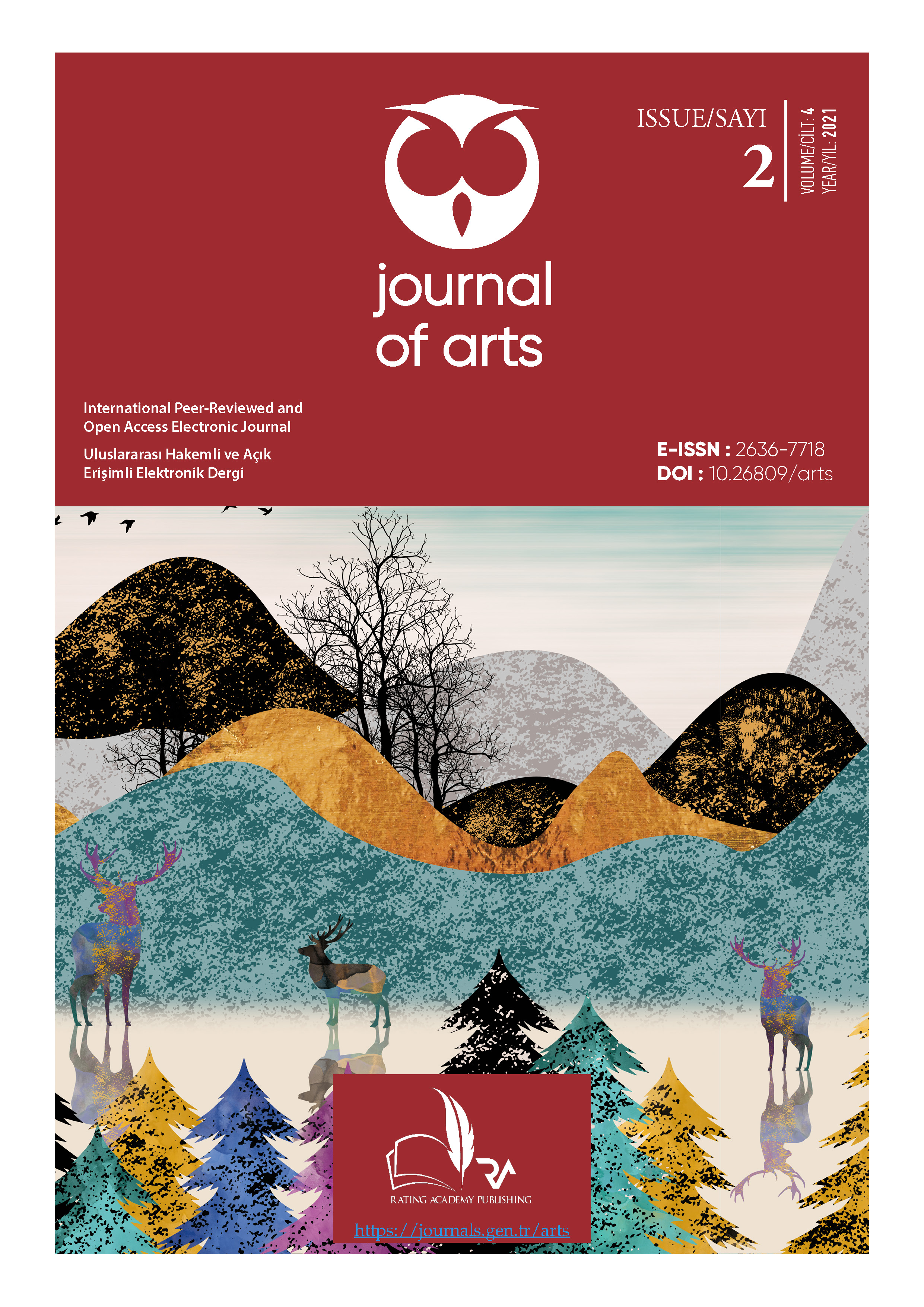Abstract
The human brain often prefers to operate at an unconscious level rather than at the conscious level. Thus, it can perform many different jobs more accurately and faster by saving energy. Although the operation of our brain at the subconscious level is considered as a natural process, it is of great importance to activate the conscious mind against the formations that manipulate people by taking advantage of this structure of the system. In this direction, the research emphasizes that the errors, deformations and malfunctions that will be created by the glitch technique applied consciously on virtual images can create a perceptual breaking moment that can save the mind from subconscious effects. Digital manipulation emerges with its structure that changes cultural values, dulls the use of consciousness and is oriented towards perception operation. Especially in the age of digital culture, the dominance of the virtual provides the necessary ground for perception orientations. Today's techno-cultural society, in which the line between virtual and real gets thinner, exhibits a conformist approach under hegemonic ideologies. In this study, which investigates the conscious perception of the effects that direct us without being aware of it, it is aimed to draw attention to the existence of unconscious manipulation and the importance of questioning in order not to adopt a conformist structure.
References
BAKAN, İ. & KEFE, İ. (2012). “Kurumsal Açıdan Algı ve Algı Yönetimi”. Kahramanmaraş Sütçü İmam Üniversitesi İktisadi ve İdari Bilimler Fakültesi Dergisi. 2(1), 19-34.
BAUDRILLARD, J. (2003). Simülakrlar ve Simülasyon. Oğuz Adanır (çev.), Ankara: Doğu Batı Yayınları
BİLSİN, A. (2007). Bilinçaltı Reklamlar Ve Bilinçaltı Reklamlarda Cinsellik Öğesinin Kullanılması. (Yüksek lisans tezi). Gazi Üniversitesi Sosyal Bilimler Enstitüsü, Ankara.
CEYLAN, S. (2019). Yeni Medya Sanatı Olarak Glitch Art Ve Kinetik Tipografi Arasındaki Görsel İlişki (Cumalıkızık Örneği). (Yüksek lisans tezi). Kütahya Dumlupınar Üniversitesi Sosyal Bilimler Enstitüsü, Kütahya.
EAGLEMAN, D. (2011). Incognito. Zeynep Arık Tozar (çev.), İstanbul: Domingo Yayınevi.
FERHAT, S. (2016). “Dijital Dünyanın Gerçekliği, Gerçek Dünyanın Sanallığı Bir Dijital Medya Ürünü Olarak Sanal Gerçeklik”. TRT Akademi. 1 (2), 724-746.
FREUD, S. (2007). Psikanalize Yeni Giriş Dersleri. Selçuk Budak (çev.), İstanbul: Öteki Yayınevi.
GEÇTAN, E. (1998). Psikanaliz ve Sonrası. İstanbul: Remzi Kitabevi.
GÖÇ, S. (2017). Yeni Medya Sanatı Olarak Glitch ve Görsel İletişim Yansıması. (Yüksek lisans tezi). Anadolu Üniversitesi Sosyal Bilimler Enstitüsü, Eskişehir.
HOŞGÖR, K. (2016). “Algı Problemi Üzerine”. Kilikya Felsefesi Dergisi. (1), 12-29.
İNCEOĞLU, M. (2010). Tutum, Algı, İletişim. İstanbul: Beykent Üniversitesi Yayınları.
KANAT, S. (2018). “Glitch Sanatı”. İnönü Üniversitesi Kültür ve Sanat Dergisi. 4(2), 28-35.
KARA, Ö. (2020). “Thomas Reid’in Algı Teorisinde Görme”. Akademik Platform İslami Araştırmalar Dergisi. 4(2), 250-267.
KARAPINAR, A. (2012). “Gerçeklik Ve Hiper Gerçeklik; Baudrıllard Ve G.Debord Anlatılarından Hareketle “Hakikatin Yeniden İnşası””. Uluslararası Sosyal Araştırmalar Dergisi. 10(53), 513-518.
KÜÇÜKBEZİRCİ, Y. (2013). “Bilinçaltı Mesaj Gönderme Teknikleri Ve Bilinçaltı Mesajların Topluma Etkileri”. International Periodical For The Languages, Literature and History of Turkish or Turkic. 8(9), 1879-1894.
OKANLI, A. Çocuk Psikolojisi Ve Ruh Sağlığı [online]. Atatürk Üniversitesi Açık Öğretim Fakültesi (s. 2-15), https://www.ataaof.edu.tr/Dosyalar/CocukPsikolojisiVeRuhSagligi.pdf [Erişim Tarihi: 11 Mayıs 2020]
ÖVÜR, A. (2017). “Bilinçaltı Etkileme Yöntemleri Ve Kitle İletişim Araçlarındaki Uygulamaları”. The Turkish Online Journal of Design, Art and Communication. 1 (7), 25-35.
ÖZCAN, M. (2004). Bilişsel Bilin Çerçevesinde Filmsel Anlatı ve Görsel Algılama. (Yüksek lisans tezi). Ankara Üniversitesi Sosyal Bilimler Enstitüsü, Ankara.
ÖZCAN, M., TAŞKIN, D. & BAYSAL, K. (2015). “Video Görüntülerindeki Subliminal Çerçevelerin Tespiti Üzerine Bir Yöntem Önerisi”. Ejovoc (Electronic Journal of Vocational Colleges). 5 (4) , 94-103
ÖZYURTÇU, H. (2020). Glitch Sanatı ve Resim Sanatında Glitch Tekniğinin Etkileri Üzerine Bir Araştırma. (Yüksek lisans tezi). Yeditepe Üniversitesi Sosyal Bilimler Enstitüsü, İstanbul.
PELHAM B.W., CARVALLO M. & JONES JT. (2005). “Implicit Egotism”. Current Directions in Psychological Science. 14(2), 106-110
SEVİNÇ, K. (2019). “Freudyen Psikolojide Bilinçaltı ve Bilinçdışı Kavramları Arasındaki Benzerlikler ve Farklılıklar”. Kilitbahir. (15), 125-158.
SIRMALI, E. (2019). Çağdaş Sanat’ta Yaratım Süreci Olarak Manipülasyon. (Yüksek lisans tezi). Bursa Uludağ Üniversitesi Sosyal Bilimler Enstitüsü, Bursa.
TUZCUOĞLU, N. (1995). “Psikanaliz Kuramı ve Özellikleri”. Marmara Üniversitesi Atatürk Eğitim Fakültesi Eğitim Bilimleri Dergisi. (7), 275-285.
USLU, Y. (2016). “Görsel Bozulmanın Adı; Glitch Art”. İdil. 5(27), 1967-1976.
ÜRPER, O. (2009). Dijital Teknolojiye Geçişin Reklam Fotoğrafçılığı Uygulamalarına Yansımaları: Türkiye’deki Reklam Fotoğrafçılarının Görüşlerinin Değerlendirilmesi. (Doktora tezi). Marmara Üniversitesi Sosyal Bilimler Enstitüsü, İstanbul.
VOKEY, J. R. (2013). Subliminal Massages, Chapter 29, Psychological Sketches (7th Edition). Lethbridge: Psyence Ink.
YAZAR, T. & YALÇIN, İ. (2018). “Dijital Teknoloji Ve Fotoğraf Sanatı”. Uluslararası Sosyal Araştırmalar Dergisi. 11(60), 612-621.
YENİÇERİ, Ö. (2011). “Konformizm, Yozlaşma Ve İtaatsizlik”. Istanbul Journal of Sociological Studies. 0 (44), 69-90.
ZAJONC, R. B. (1968). Attitudinal Effects Of Mere Exposure. Journal of Personality and Social Psychology Monographs, 9(2, Pt. 2), 1–27.

This work is licensed under a Creative Commons Attribution 4.0 International License.
Copyright (c) 2021 Holistence Publications


